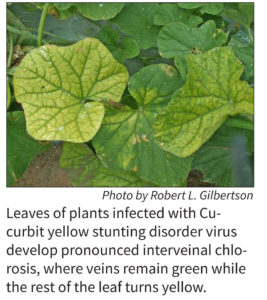Your Garden … with Kate Russell: Protect your cucurbits from white-flies for an abundant harvest this fall
 By Kate Russell
By Kate Russell
If you see yellow spots that spread to fill the spaces between leaf veins, your melon or squash plants may have cucurbit yellow stunting disorder. Cucurbit yellow stunting disorder (CYSD or CTSDV) is a viral disease of cucurbits, carried by whiteflies.
Cucurbits are popular Gilroy garden plants. Delicious summer squash, winter squash, watermelon, muskmelons, pumpkins, and cucumbers are the reason many of us garden. If you see whiteflies in your garden, your cucurbits may have a bigger problem. To reduce the chances of this disease spreading from one plant to another, it is a good idea to learn how to recognize the symptoms in its earliest stages.
CYSD Symptoms
The first symptoms of CYSD look a lot like water stress, as the virus begins spreading throughout the plant. Then, yellow spotting on older leaves will develop. This yellow spotting can also mean the plant has a molybdenum deficiency, or that it has cucurbit aphid borne yellow virus (CABYV). You can take a leaf sample to your nearest county farm advisor, where they will conduct a molecular test to verify the disease.
If the chlorotic areas spread to the point that the entire leaf is yellow, except for the veins, it is likely to be CYSD. Small green patches may appear in the yellow areas.
Other symptoms include leaves curling upwards and becoming brittle. As the disease progresses and the vascular system breaks down, older leaves are dropped and fruit is neglected, as the plant tries to protect itself. This makes fruits smaller, less flavorful, and more prone to pests and other diseases. Also, fruits from infected plants do not store as well as fruits from healthy plants.
Controlling CYSD
There are no effective chemical or biological controls. Since CYSD is spread by whiteflies, whitefly control is key to halting the spread of this viral disease. These tips can help reduce the chances of CYSD spreading through your garden:
- Only use high quality, disease-free seeds
- Quarantine and carefully inspect new plants for signs of disease or whiteflies
- Avoid using broad-spectrum pesticides, which kill whitefly predators
- Use floating row covers over newly planted seeds and seedlings
- Remove and destroy infected plants
- Fertilize and irrigate established plants correctly, to keep them as healthy as possible
- Implement crop rotation practices in your garden or foodscape
Protect your cucurbits from whiteflies for an abundant harvest this summer and fall.
Kate Russell is a UCCE Master Gardener in Santa Clara County. For more information, visit mgsantaclara.ucanr.edu or call (4080 282- 3105 between 9:30 a.m. and 12:30 p.m. Monday through Friday.
